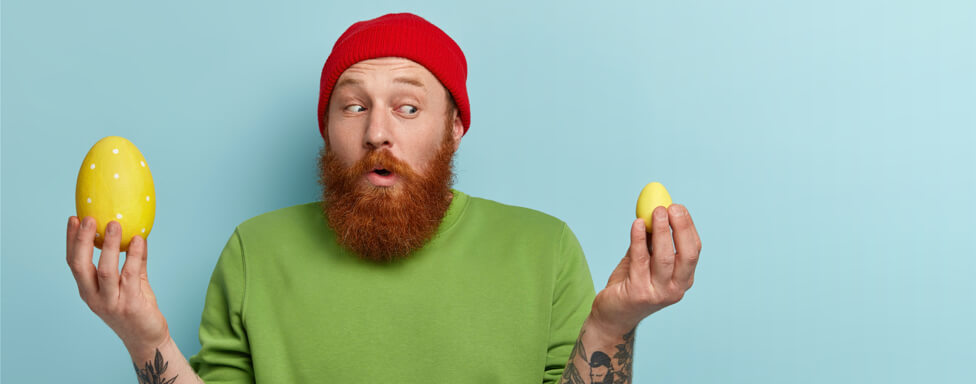This blog post is a follow up to my previous blog post, which explained how to manage the display of error message on A2C section. By adding one mixin, you will be able to manage the position of error message on any form on any page. Let’s get the show on the road!
Read moreBlog
5 Key Elements of eCommerce Domination, With Examples From One Unexpected Company
There are some things all successful eCommerce websites have in common. From our 12 years of experience on the market and hundreds of eCommerce websites developed, we’ve identified 5 key elements that lead to eCommerce domination.
What is it that you need to do to build a successful eCommerce website? We suggest these 5 key elements.
Read moreSkills to run an eCommerce business
What are the essential skills needed to run an eCommerce business? Starting, and then managing a business of any kind, is a dream for many people out there. But, how do you start? What do you need to know before starting an online business, and how can you build a team to help you grow? Read on to find out.
Read moreAdd static content in Magento Checkout address form
If you are reading this, you are probably looking for an easy way to add static content to the Checkout address fieldset.
If you open the Magento Checkout module, you will notice technology complexity of the Magento Checkout. When you consider Knockout, HTML, PHTML, XML, JS – such a mix of technologies can often make a simple straightforward task seem super complicated.
Usually, if you need to edit something on the Checkout, you need to create a custom module, which will override the Layout Processor. This approach makes sense if the Checkout modification is complex and there needs to be some kind of a dynamic.
But for simple tasks, such as updating input placeholders, adding the notes to the inputs or adding the text between inputs – custom modules are an overkill.
Let me share with you a simple frontend solution for situations when we need to add some text or an image banner, for example between the Last Name input and the Company input.
Read moreeCommerce Returns Management – a simple solution from the Fashion industry
Returns can be a major headache for eCommerce retailers. While in-store purchases don’t get returned so often, there are estimates that customers return up to 40% of goods bought online.
This is especially the case in the Fashion & Apparel industry. Online store customers can’t touch the product, hold it nor feel it during online shopping.
Some customers deliberately resort to the practice of over-ordering. This increases the quantity of returns and their negative environmental footprint.
Since the Covid-19 pandemic turned the online store into the only sales channel for many retailers, the problem with returns is more critical than ever.
In this blog post, we’ll demonstrate how one of our clients improved their returns management by developing a custom Returns Portal on the Magento platform.
Read moreSEO vs. PPC: Structured data markup for product variants
You did it – you finally did it! You’ve implemented all recommended schema.org types and properties throughout your Magento store only to see Google Merchant Center warning you for “Insufficient match of microdata price information”. Let’s admit it – we’ve all been there at least once.
Although we don’t usually face this issue on simple product pages (since product markup on these pages is pretty straightforward), we can often find it on product variants.
Since setting up correct structured data markup on grouped and configurable products isn’t always easy as it seems, I’ve prepared this short guide that should serve you for both SEO and PPC purposes.
Read moreGoogle is concealing your search terms, and it is bad
Let’s first read the following premise: For successful optimization and revenue-generating Google Ads campaigns, you need access to ALL search terms for which users clicked on your ads.
It’s simple logic. You want to know what users searched for when they clicked on your ads, and then converted. Am I right?
Not if you ask Google about it. Read on and find out why Google is behaving f…[CENSORED] bad with this one.
Read more5 UX improvements for Magento checkout page design
Magento 2 checkout page is the crucial page of your Magento 2 store. It is the final stage of the checkout flow and only motivated users interested in purchasing your products will reach this step.
Many still remember the complicated 6-step Magento 1 checkout. Compared to that, checkout in Magento 2 has been significantly improved. Yet, there are some usability problems that we encountered during our analyzes, and there’s always room for improvement.
In this blog post, we’ll suggest design improvements for 5 known usability issues on the checkout page in Magento 2
Read moreHow does Google calculate the monthly budget of your campaigns?
In Google Ads campaigns we can set only daily budgets. Not monthly budgets. But the monthly budget is dependent on the daily budget in more ways than one.
There are situations in which Google can spend over double your daily budget. Not only that, but it can also be spent several times over. In that case, don’t be scared if you see the “monthly charging limit reached” message.
Here we’ll describe how Google calculates your monthly budget. This is essential to understand if you have some overspent budget on your campaigns.
Read moreSchema Markup for eCommerce Websites
Each time someone searches a particular product online, they end up on a SERP that (in most cases) includes a gazillion results.
Since the chances of browsing through all of these links are little to none, it’s essential to make your business stand out.
The best way to do it is to add structured data markup throughout your online store.
Read moreNot in Buy Box – Status Meaning
What happens when you decide to check your advertising campaigns on Amazon, finding a message for one of your products saying “Not in Buy Box”?
Do you need to worry when you see that there are no impressions for that product?
The answer is straightforward.
Read moreImpressions in Amazon Advertising Are Not All The Same – Meet The Differences
To do meaningful Amazon PPC optimization, we have to have the necessary data to analyze and improve.
This post is going to be about Impressions metrics on Amazon Sponsored Product ads.
Its main goal is to save you some time and show you that Amazon advertising impressions on different reports really are different and you aren’t delusional 🙂
Long story short: The impressions metrics you found are different. The data you are looking at is correct.
In case you want to understand what’s the difference, continue reading.
Read moreGetting started with eCommerce personalization
At the most basic level, personalization is a way of delivering specific content to different customer groups to increase conversion rate and revenue and enhance user experience. When done right, personalization can improve user experience by providing the right content at the right time.
That user-related benefit can easily translate to company benefits such as growth in conversions, revenue, customer engagement, and loyalty.
Keep in mind: personalization is not to be confused with customization. The main difference between the two is that personalization doesn’t require user’s active engagement. You personalize the experience for them. On the other hand, customization requires user’s active involvement.
Read moreHow to Check Buy Box Eligibility on Amazon?
You probably understand the importance of the Buy Box on the Amazon product page and its impact on sales.
Here’s a fact that might surprise you – almost 90% of all sales on Amazon go through the Buy Box.
This is not a blog post about how to get Buy Box on your product landing pages or what metrics can influence eligibility.
This is a blog post about how to check Buy Box eligibility for single products.
Read moreMonthly Charging Limit Reached in Google Ads?
What happens when you suddenly see a message in your Google Ads account that says “Your monthly charging limit is reached”?
You might think at first that your monthly budget is depleted. But then you realise: there is no monthly budget. Google Ads campaigns work on a daily budget.
You can’t set a monthly budget on your Google Ads campaigns.
You again read the full message. This time you might notice the word “charging”. Now, this could be the sign of a big problem when it comes to charging your credit card.
Read moreWhat’s New in Magento 2.4? Features and Benefits for Merchants Explained
Released on 28 July 2020, the new Magento 2.4 comes with a long list of new features, bug fixes and security enhancements to the world’s no.1 e-Commerce platform.
What is new in Magento 2.4?
- New and improved default search engine
- Improved Media Gallery
- New feature Seller-Assisted Shopping
- New feature Purchase Approval Workflows (only for Magento Commerce)
- Two-factor authentication for improved security
- Higher technical requirements overall
Best practices for Magento cart page design
The shopping cart sits near the end of the shopping flow – just a step before the actual checkout and payment process. It’s the place where totals, discounts, taxes, and shipping costs get calculated. Most importantly, it is a magical place where the final purchase decision often happens.
Besides providing an order overview, the cart page is also an ideal place to show some vital purchase information that can weigh in the purchase decision. It can also offer products for impulse shopping to increase the average cart value.
However, we often see shopping cart pages having high abandonment rates. There are many disappointments customers can face on the cart page and leave the store before completing the purchase. Here are some tips for Magento cart page design to lower those abandonment rates and push your customers to the checkout!
Read moreMagento 2 Webhook Notifications
Webhooks are used to indicate when an important event has occurred, usually by sending a notification in the form of a message to a specified webhook URL or endpoint. This can be really useful for certain events, like when a customer makes an order or leaves a comment.
It can also be a really handy way for developers to get instantly notified when an exception occurs, providing them with the information they need to quickly locate and fix the issue.
In this article, I will show you how to create a module that allows you to configure your very own webhooks for Magento 2, utilizing the Incoming Webhooks feature from Slack.
Read moreIs now the time to invest in PWA for your Magento website? Top questions for merchants answered.
Progressive Web Applications (PWAs) are the next big thing in eCommerce. This topic has been on everyone’s lips and under everyone’s fingertips from the initial conversations around Magento 2 frontend and the introduction of the headless concept.
If you are a merchant considering this new frontend concept, you may be wondering what the fuss is all about, whether it makes sense to invest in PWAs, and how big of an investment should you plan? Here is a quick rundown of the main questions and answers for anyone still on the fence about PWAs in Magento, from a merchant’s perspective.
Read moreBest practices for Magento product page design
Product pages are the center stages of any web store. They carry significant weight in the purchase decision, and they are often the landing pages for people coming from search engines. It’s, therefore, important that product pages perform flawlessly for the customers.
Magento’s product page layout comes with several key elements, such as product name, product gallery, descriptions, pricing, CTAs, reviews, and upsells. Still, it leaves plenty of room for enhancements that can be incorporated into the product page design.
We’ll cover some of the fundamentals of Magento product page design and see how we can utilize existing elements and expand them to achieve more benefits for both your customers and your eCommerce business!
Read moreWill it Fit? Must Have Features for Automotive eCommerce
If you’ve landed on this blog post, you’re probably wondering what are the must-have features to run a successful eCommerce store in the automotive industry. One of the biggest UX challenges for automotive aftermarket businesses selling online is to show their customers auto parts that will fit their vehicles. With thousands of car models and millions of aftermarket and OEM parts out there, how can you create a slick eCommerce experience that will ease the path to purchase?
Read on to see the best practices and some solutions for the businesses in this industry.
Read moreWhen is the time to start selling online?
Traditional buyer journey was quite predictable. It used to have clear cuts which most customers followed – you could actually draw a linear line in between their needs and final conversions. From awareness stage, to consideration and final decision all they needed was information.
The rise of the internet completely transformed entire buyer journey, creating research driven individuals who have a completely non-linear and unpredictable path to you. Suddenly the fact that there are no information about your business or that your products can’t be ordered online makes much difference for a massive part of buyers – online shoppers. After everything we learned about how people interact with internet before finally making that buying decision, it’s almost business suicide for any retailer not to sell online.
Read moreAre you ready for Gen Z eCommerce?
The next wave of consumers is here. And they are on their way to becoming the biggest group of all. Maybe it’s enough to say that this group has never known a world without the internet or mobile phones.
Given only that, they will certainly make the world of eCommerce change its “old ways.” It is becoming crucial to reveal the habits and attitudes of your future customers – without understanding them, you are losing potential future revenue.
Read moreACES and PIES – Data Challenges in the Automotive Aftermarket Industry
One of the main challenges for merchants in the automotive aftermarket industry is handling large volumes of data. There are thousands of vehicles, and millions of replacement parts out there.
And you would think this information should all be standardized and easy to use, right? Well, guess again. Read on to find out what are ACES and PIES, and how merchants are solving the data problem in their businesses.
Read more47 questions to ask eCommerce clients
Ecommerce isn’t easy. Or, to be more precise, it isn’t easy if you want to do it right from the start. If you want a good, quality product, you must be ready to invest a lot of time and effort in research.
In this blog post, we have written down some of the most common questions intended for eCommerce clients to make things quicker and more fluid.
Read moreAutomotive Aftermarket Industry – eCommerce Challenges for Merchants
What’s the state of Automotive Aftermarket eCommerce in 2020? What are some of the common pain points of businesses in the aftermarket auto parts industry?
How are they solving challenges with large catalog handling, product fitments, and user experience? Are they making it easy for their customers to find exactly what they are looking for?
Read on to learn more about the trends and most common issues merchants are trying to solve.
Read moreChoose the best eCommerce platform for auto parts
What is the best eCommerce platform for automotive industry? How to find the one that meets your needs? What is more important – time to market, ease of use, customizability? How can you be sure you made a good decision? And why don’t you just use Amazon instead?
Read on to find out how to choose the best platform for your business and download our automotive marketing success guide.
Read moreHow Many eCommerce Sites are Powered by Magento in 2020?
From time to time we encounter a question that sounds something like this: “How many eCommerce sites out there are built on Magento?”
The answer to this question is not easy to give. This is because the data needed to give this answer is in a way both easy and hard to find.
But, we will try to give you some sense of the general number of the Magento eCommerce sites in this post.
Read moreHow to programmatically create customers in Magento 2.3.x
There are several ways to create customers in Magento 2. A customer can create an account on their own using the sign-up form, a customer can be created through the admin interface, and there is even a built-in Magento 2 import feature that can mass import a huge number of customers from a CSV file, provided that the customer data in the CSV is import-ready.
But what if we have thousands of customers whose data still needs to be processed before they can be created? The best way to do this would be to create the customers programmatically.
In this article, we are going to cover the topic of creating customers programmatically, and to this purpose, we are going to create a simple Magento 2 module which is going to have a custom console command and a couple of models that are going to be used to read, process and create customers.
Read more




























